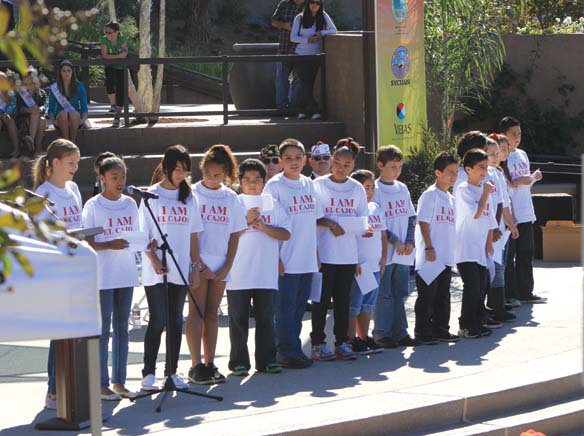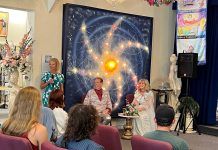In honor of the El Cajon Centennial, which took place on Monday, Nov. 12th throughout downtown El Cajon, Lynn Caruso, a teacher at Chase Avenue Elementary School gave a presentation at the local library addressing the El Cajon Historical Society called “The Child’s Eye View of Old El Cajon”
In honor of the El Cajon Centennial, which took place on Monday, Nov. 12th throughout downtown El Cajon, Lynn Caruso, a teacher at Chase Avenue Elementary School gave a presentation at the local library addressing the El Cajon Historical Society called “The Child’s Eye View of Old El Cajon”
The topic discussed was the role of school in old rural El Cajon during the time that settlers were moving into the area. Caruso has always felt herself drawn to the stories of teachers in early 20th Century El Cajon, which was then named the “Valley of Opportunity.”
Caruso talked to the audience about what life was like for children then, particularly as related to school. For example, she explained that a favorite teacher among the children at that time was Miss Josephine Asher. At 28 years- old, she was paid $60 a month to teach 16 children.
The rules back then for teachers were quite different, explained Caruso. “She had to be single, so Miss Asher continued to live with her family at their home, which was located where the Sears store in El Cajon’s Parkway Plaza currently stands,” she said.
Leslie Stell, one of Miss Asher’s students, would get up at 6 a.m. each morning before school started and help her mother make breakfast. Then she cleared the table and did the dishes. She would be all ready for school, wearing a long dress over bloomers, a slip and a knitted shirt.
Her lace-up high-top shoes got dust on them as she walked to school alongside vineyards and through fields. When the young girl got to the schoolhouse, the first bell sounded at 8:30 a.m.
“Nobody was allowed on the playground before then,” Caruso said. “When that bell rang, all the girls went to play on the swings and the see-saw.”
Stell’s classmate Roger Beatty would also have gotten up early that morning. His chores had been to feed the chickens and carry firewood into the house. He dressed in knickers, a long white shirt and long, black stockings; his shoes were also high-tops.
Once at school, Beatty liked to play tops or ball or a game of shinny with other boys, “when the teachers weren’t looking,” Caruso said.
Shinny was played with a tin can that they moved along the ground with a stick down the length of the field. “But tin cans have sharp edges, so that’s why teachers never liked that game,” Caruso said.
Beatty was like nearly every boy in school back then in that his favorite subject in school was recess. “He lived for recess,” Caruso said, to which everyone in the audience laughed.
At 8:55 in the morning, two 8th graders would pull the rope in the bell tower. It was time for the school day to begin.
First there was math, then reading, then a short 15-minute recess at 10:30 a.m. Once back in the classroom, Miss Asher would teach them Geography and History.
Something that every child had at their desk was a pencil box, usually constructed from wood. “Every boy and girl loved having their own box to put their supplies in,” Caruso said. “They just don’t make them like that anymore. That’s why I go out of my way to look for them in antique store for my own collection.”
When lunch hour came around, the boys and girls had an hour. They had either brought their lunch to school and would eat and share it with others on the school grounds, or they walked home for lunch.
After lunch, it was always the best time for Miss Asher to read a story to the class. Next on the day’s agenda was art and music. “The arts were very important in those days,” Caruso said.
At the end of the school day, Beatty would walk home with his friends from school, stopping to gather grapes from the field—and a good old-fashioned grape fight.
At home, Leslie and her friends would play with dolls or play Parcheesi or a board game until about 4:30 p.m.,” Caruso said. “All the children were in bed by 8:30 p.m.. Now that’s a parents’ dream today, isn’t it?” Caruso said, laughing.
Somewhere in between all those school lessons and games of Checkers and boxes of Cracker Jacks eaten, Leslie Stell and Roger Beatty grew up and fell in love with each other, marrying years later. In 1955, Miss Josephine Asher (who later married a Mr. Vacher) was honored and dedicated for her years of service in education.
“I grew up on the East Coast where the history always seemed to be about the same things and people. I mean, where do you go back there that George Washington hasn’t gone?” Caruso said.
People in the audience laughed. “So when I moved to California and discovered all the colorful history, I was excited,” she said.
Also included during the centennial was a Readers’ Theater presented by Caruso’s 3rd, 4th and 5th grade students, who read a skit called “I Am El Cajon,” written by one of their classmates. For more information about El Cajon history, go to www.elcajon100.com.














